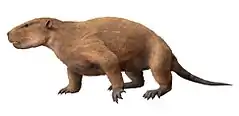| Bubodens | |
|---|---|
| Scientific classification | |
| Domain: | Eukaryota |
| Kingdom: | Animalia |
| Phylum: | Chordata |
| Class: | Mammalia |
| Order: | †Multituberculata |
| Suborder: | †Cimolodonta |
| Superfamily: | †Taeniolabidoidea |
| Genus: | †Bubodens Wilson, 1987[1] |
| Species: | †B. magnus |
| Binomial name | |
| †Bubodens magnus Wilson, 1987[2] | |
Bubodens magnus is an poorly understood, extinct multituberculate mammal from the Upper Cretaceous of South Dakota. It is known only from a single tooth, and has uncertain placement within the suborder Cimolodonta though has been tentatively argued to belong to Taeniolabidoidea.[3] This species is the only known member of the genus Bubodens, and may have been the largest known mammal of the Cretaceous.[4]
References
- ↑ "PaleoDB taxon number: 39782". Fossilworks from the Paleobiology Database.
{{cite web}}: CS1 maint: postscript (link) - ↑ "PaleoDB taxon number: 44722". Fossilworks from the Paleobiology Database.
{{cite web}}: CS1 maint: postscript (link) - ↑ Kielan-Jaworowska, Zofia; Cifelli, Richard L.; Luo, Zhe-Xi (2004). Mammals from the Age of Dinosaurs: Origins, Evolution, and Structure. New York: Columbia University Press. doi:10.7312/kiel11918. ISBN 978-0-231-11918-4.
- ↑ Williamson, Thomas E.; Brusatte, Stephen L.; Secord, Ross; Shelley, Sarah (5 October 2015). "A new taeniolabidoid multituberculate (Mammalia) from the middle Puercan of the Nacimiento Formation, New Mexico, and a revision of taeniolabidoid systematics and phylogeny". Zoological Journal of the Linnean Society. 177: 183–208. doi:10.1111/zoj.12336.
This article is issued from Wikipedia. The text is licensed under Creative Commons - Attribution - Sharealike. Additional terms may apply for the media files.

